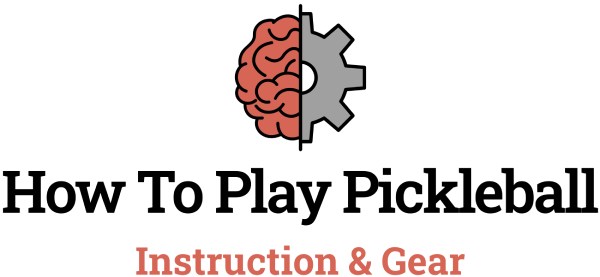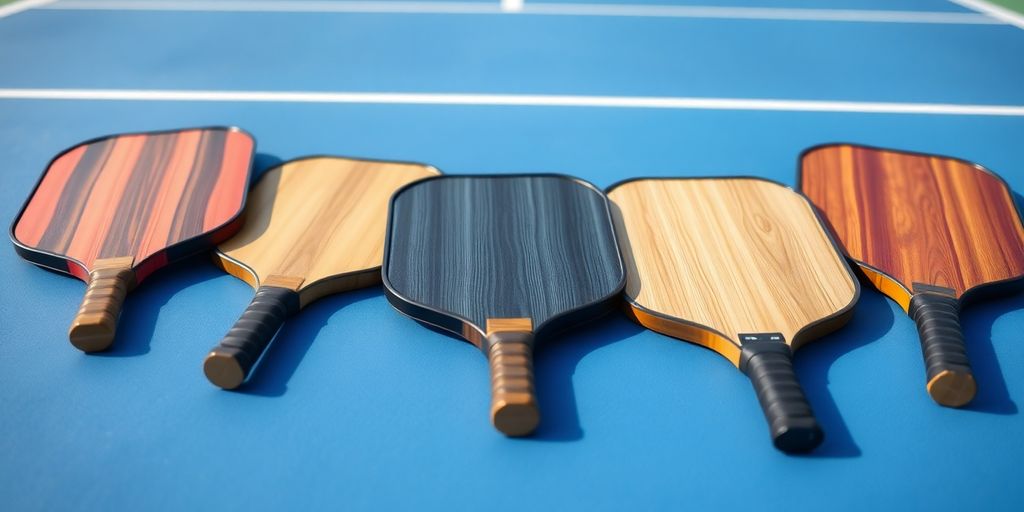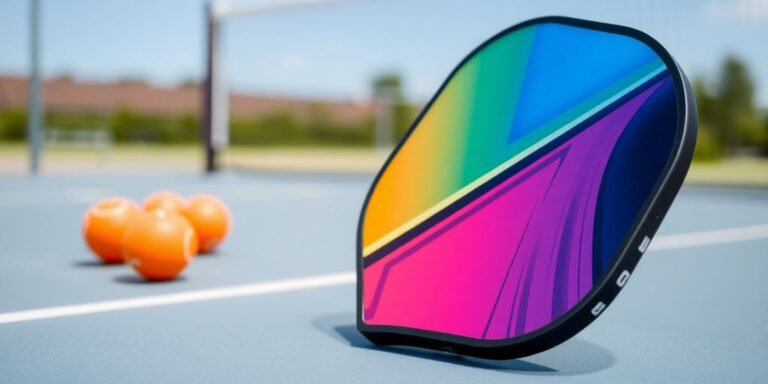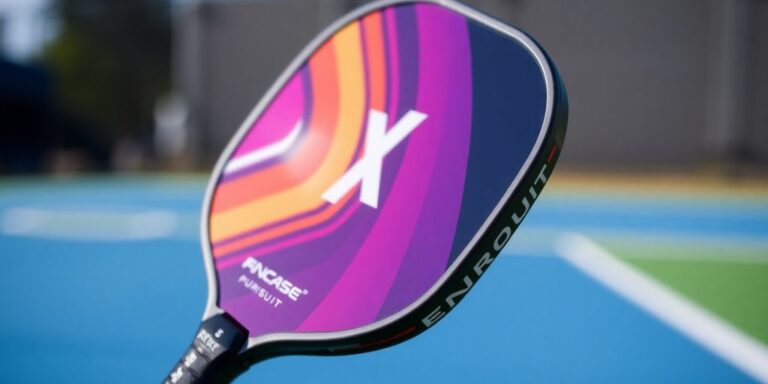So, you’re ready to jump into pickleball, or maybe you’ve played a bit and now you’re thinking, “Okay, how do I pick pickleball paddles that actually make sense for me?” It can feel like a lot. There are so many options out there, and it’s easy to get lost in all the different terms. But don’t worry! This guide is here to help you figure out what really matters when you’re looking for your next pickleball paddle. We’ll break down the important stuff, so you can make a good choice without getting overwhelmed.
Key Takeaways
- The core material of a pickleball paddle affects how much control or power you get.
- Paddle thickness changes how the ball feels off the paddle and how much power you can generate.
- Different surface materials, like graphite or fiberglass, give you different levels of touch, spin, and durability.
- The weight of your paddle impacts your swing speed, power, and how easy it is to move around.
- Getting the right grip size is super important for comfort and to make sure you can play your best.
Understanding Core Materials For Your Pickleball Paddle
When you’re looking at pickleball paddles, the core material is a big deal, even if you can’t see it. It’s like the engine of a car; you don’t see it running, but it makes all the difference in how the car performs. Different core materials give you different feels and play characteristics, so picking the right one for your game is pretty important.
Polymer Cores: The Standard For Control
Polymer cores are probably the most common type you’ll find in pickleball paddles today. They’re made from a plastic honeycomb material, and they’re known for offering a really good balance of control and feel. If you’re a player who likes to place the ball precisely and wants a softer touch for dinks and drops, a polymer core is often the way to go. They tend to absorb more of the ball’s energy, which means less pop but more control over where the ball lands. This makes them great for players who prioritize finesse over raw power.
- Excellent vibration dampening.
- Provides a softer feel for better touch shots.
- Generally quieter than other core types.
- Very durable and long-lasting.
Nomex Cores: Power And Pop
Nomex cores are made from a aramid fiber honeycomb, and they’re known for their stiffness and density. If you’re looking for a paddle that gives you a lot of power and a noticeable "pop" when you hit the ball, Nomex is a strong contender. These cores transfer more energy to the ball, which can be great for driving shots and serves. However, that extra power often comes at the cost of some control and a louder sound on impact. They were among the first core materials used in pickleball, so they have a bit of history.
Nomex cores are often favored by players who have a more aggressive, power-oriented game. The firm feel and responsive nature can help generate significant ball speed, but it requires a bit more precision from the player to keep shots in bounds.
Aluminum Cores: Lightweight And Responsive
Aluminum cores are less common than polymer or Nomex these days, but they still have their place. They’re typically very lightweight and offer a good blend of responsiveness and feel. Paddles with aluminum cores can provide a decent amount of power without being overly stiff, and they often have a nice, crisp feel when you make contact with the ball. They might not have the raw power of Nomex or the ultimate control of polymer, but they can be a good middle-ground option for some players. When considering a new paddle, think about the pickleball paddle facing materials as well, as they work together with the core to define performance.
Here’s a quick comparison of the core types:
| Core Material | Primary Benefit | Secondary Benefit | Feel | Sound |
|---|---|---|---|---|
| Polymer | Control | Touch | Soft | Quiet |
| Nomex | Power | Pop | Firm | Loud |
| Aluminum | Responsiveness | Lightweight | Crisp | Moderate |
Understanding these core materials is just one piece of the puzzle when picking out your ideal paddle. You also need to think about things like the paddle’s weight, its surface material, and even the grip size. And don’t forget about the top pickleball ball brands to go with your new paddle!
The Impact Of Pickleball Paddle Thickness
When you’re looking at pickleball paddles, one thing that might not immediately jump out at you is the thickness of the paddle’s core. But trust me, this detail makes a huge difference in how the paddle plays. We’re talking about the depth of the internal core, usually measured in millimeters. A thicker core feels different, plays different, and can really change your game.
Thick Cores For Enhanced Control
Thicker paddles, generally around 16mm or more, are all about control. Think of it like this: a thicker core has more material to absorb the ball’s energy when it hits the paddle. This dampening effect means the ball stays on the paddle face a tiny bit longer, giving you more time to guide your shots. This extended contact time is key for precise placement and soft shots like dinks and drops. If you’re a player who loves to control the pace of the game, placing the ball exactly where you want it, a thicker paddle might be your best friend. It helps reduce errant shots and gives you a more forgiving feel, which is great for newer players still getting a feel for the game. For those just starting out, a medium core thickness can be a good starting point.
Thin Cores For Increased Power
On the flip side, thinner paddles, often in the 10mm to 13mm range, are built for power. With less material in the core, there’s less energy absorption. When the ball hits a thin paddle, it springs off faster, almost like a trampoline. This translates to more pop on your serves, drives, and overheads. If you’re someone who loves to hit hard and put opponents on the defensive, a thinner paddle will give you that extra oomph. However, this power comes at a cost: you’ll have less control, and the sweet spot might feel a bit smaller. It takes more precision to consistently hit powerful shots with a thin paddle, so they’re often favored by more experienced players who can handle the reduced forgiveness. Some composite pickleball paddles are designed with thinner cores to maximize power.
Finding Your Ideal Thickness
Choosing between a thick or thin paddle really boils down to your playing style and what you prioritize on the court. There’s no one-size-fits-all answer, and many players find a happy medium. Here are some things to consider:
- Your Skill Level: Beginners often benefit from thicker paddles for better control and forgiveness. More advanced players might lean towards thinner paddles for power.
- Your Play Style: Do you prefer to dink and place shots, or do you like to drive the ball and hit winners?
- Arm Comfort: Thicker paddles can sometimes feel a bit softer on the arm due to their dampening properties, which can be a factor if you have arm issues.
- Paddle Material: The core material also plays a role. For example, some Engage Pickleball Paddles might offer different thicknesses with various core materials, affecting the overall feel.
It’s a balancing act, really. You gain control with thickness but might lose some power, and vice versa. The goal is to find that sweet spot where the paddle complements your natural game, helping you play your best without fighting against your equipment. Don’t be afraid to try out different thicknesses to see what feels right in your hand and on the court.
Choosing The Right Surface Material For Your Pickleball Paddle
Selecting The Optimal Pickleball Paddle Weight
Lightweight Paddles For Agility
When you’re looking for quick reactions and fine-tuned control, a lighter paddle can be your best friend. These paddles typically weigh less than 7.3 ounces. They let you move the paddle around really fast, which is great for those tricky net shots and quick volleys. If your game is all about finesse and placing the ball exactly where you want it, a lightweight option might be perfect. However, there’s a trade-off: you might find yourself putting more effort into generating power, and over time, this can lead to arm fatigue. It’s like your arm has to do more of the work because the paddle isn’t absorbing as much impact.
Mid-Weight Paddles For Balance
Mid-weight paddles are often considered the sweet spot for many players, especially those just starting out. These usually fall between 7.3 and 8.5 ounces. They offer a good mix of both power and control, making them pretty versatile for different play styles. You get enough pop on your shots without sacrificing too much maneuverability. It’s a solid choice if you’re still figuring out your preferred style or if you want a paddle that can handle a bit of everything. Many players find this weight class provides a comfortable balance for extended play without excessive strain.
Choosing the right paddle weight is a personal journey, and what feels good for one player might not for another. It’s not just about the numbers on a scale; it’s about how the paddle feels in your hand during play and how it complements your natural swing. Don’t be afraid to try out a few different weights to see what truly clicks with your game.
Heavyweight Paddles For Power
If you’re all about hitting powerful drives and serves, a heavier paddle (typically 8.5 ounces and up) could be what you need. These paddles naturally generate more force behind your shots, meaning you don’t have to swing as hard to get the ball to go fast. They can be great for players with a tennis background, as the feel might be more familiar. However, the extra weight can make them less agile, and they might be harder to maneuver quickly at the net. Also, if you have any arm issues, a heavier paddle could make them worse over time. It’s a trade-off between raw power and overall control and arm comfort. For more details on how paddle weight impacts your game, especially regarding pickleball swing weight, it’s worth looking into.
Here’s a quick look at how different weights generally perform:
| Weight Class | Typical Range (ounces) | Key Benefit | Potential Drawback |
|---|---|---|---|
| Lightweight | Under 7.3 | Agility, Control | Less Power, Arm Fatigue |
| Mid-Weight | 7.3 – 8.5 | Balance, Versatility | Good All-Around |
| Heavyweight | Over 8.5 | Power, Stability | Less Agility, Arm Strain |
When you’re thinking about your gear, remember that your pickleball bags also play a role in how you transport and protect your paddle, so consider that too.
Finding The Perfect Grip Size For Your Pickleball Paddle
Choosing the right grip size for your pickleball paddle is a big deal. It’s not just about comfort; it directly impacts how well you control the paddle and, by extension, the ball. A grip that’s too small can make your hand cramp up and cause you to squeeze too hard, leading to fatigue and less precise shots. On the flip side, a grip that’s too big makes it tough to get a firm hold, which can mess with your wrist snap and overall power. Getting the grip size just right helps you play your best and keeps your hand happy.
Measuring Your Hand For Grip Size
So, how do you figure out your ideal grip size? There are a couple of common ways to measure. One popular method involves using a ruler. Hold your dominant hand flat, palm up. Take a ruler and measure from the middle crease of your palm (where your fingers meet your palm) to the tip of your ring finger. This measurement, in inches, is a good starting point for your grip circumference. Most pickleball paddle grips fall between 3.875 inches and 4.375 inches, usually in 1/16-inch increments. Another way is the "index finger test." Hold a paddle with a comfortable grip. If you can slide the index finger of your non-dominant hand into the gap between your ring finger and palm, and it fits snugly, that’s probably a good size. If there’s too much space, the grip might be too big. If you can’t fit your finger in, it’s likely too small.
The Importance Of A Proper Grip
Having a proper grip isn’t just about avoiding discomfort; it’s about performance. A grip that fits well allows for a relaxed hand, which translates to better feel and touch on the ball. When your hand is relaxed, you can react quicker and make subtle adjustments during play. It also helps prevent injuries like tennis elbow or wrist strain, which can happen from overcompensating with a poorly sized grip. Think of it like wearing shoes that are the wrong size—you wouldn’t run a marathon in them, right? The same goes for your paddle grip. For those just starting out, finding the best pickleball paddles for beginners often means paying attention to grip size from the get-go.
A lot of people overlook grip size, thinking it’s a minor detail. But honestly, it’s one of those things that can make a huge difference in your game. It affects everything from your serve to your dinks. Don’t just grab any paddle; take a moment to figure out what feels right for your hand. It’s worth the extra effort.
Adjusting Grip For Comfort And Performance
Even after you measure, sometimes you might need to fine-tune things. If your grip feels a little too small, you can always add an overgrip. These thin, tacky wraps go over your existing grip and can increase the circumference by a small amount, usually 1/16 or 1/8 of an inch. They also add a bit of cushioning and absorb sweat, which is a nice bonus. If your grip feels too big, it’s a bit trickier. You can’t really make a grip smaller without replacing it entirely, which isn’t always an option. That’s why it’s often recommended to err on the side of a slightly smaller grip if you’re unsure, as you can always build it up. Many of the top pickleball paddle brands offer paddles with various grip sizes, so you have options. Experimenting a little can help you find that sweet spot for comfort and control.
Matching Your Pickleball Paddle To Your Play Style

Choosing a pickleball paddle isn’t just about picking something that looks cool; it’s really about finding a tool that fits how you play the game. Think of it like this: a painter doesn’t just grab any brush, right? They pick one that helps them create their vision. Same goes for pickleball. Your paddle should feel like an extension of your arm, helping you execute your shots with precision and confidence. The right paddle can seriously improve your game, making you feel more in control and effective on the court.
Paddles For Control-Oriented Players
If your game is all about finesse, placing the ball exactly where you want it, and making your opponents run, then you’re a control-oriented player. You probably love dinks, drops, and strategic volleys. For you, the paddle needs to offer maximum feel and absorption. You’re not looking to blast the ball, but rather to guide it with accuracy.
- Paddle Weight: Lighter to mid-weight paddles (7.0-7.8 ounces) are usually best. They allow for quicker reactions at the net and more delicate touches.
- Core Material: Polymer cores are your friend. They absorb impact well, which gives you that soft feel for precise shots.
- Surface Material: Graphite or carbon fiber surfaces are ideal. They offer excellent touch and feedback, helping you feel the ball on the paddle face.
- Thickness: Thicker paddles (16mm or more) provide more stability and a larger sweet spot, which helps with consistency on those delicate shots.
When you’re focused on control, every millimeter of the paddle matters. You want a paddle that dampens vibrations and gives you a true sense of where the ball is going, allowing you to execute those tricky shots with confidence.
Paddles For Power Hitters
Are you the kind of player who loves to drive the ball, hit hard serves, and put away overheads with authority? Then you’re a power hitter. Your goal is to overwhelm your opponents with speed and force. You need a paddle that can generate serious pop.
- Paddle Weight: Mid to heavier paddles (7.9-8.5+ ounces) are generally preferred. The extra mass helps generate more power behind your swings.
- Core Material: Nomex or aluminum cores can provide more pop, though some polymer cores are designed for power too. It’s about finding that balance between power and control.
- Surface Material: Fiberglass surfaces are often a good choice for power, as they tend to be stiffer and can add more velocity to the ball. Some carbon fiber surfaces also offer good power.
- Thickness: Thinner paddles (13-15mm) can sometimes offer more power due to less absorption, allowing more energy to transfer to the ball.
Paddles For All-Around Players
Maybe you don’t fit neatly into one box. You like to mix it up, hitting some powerful drives but also capable of delicate dinks. You’re an all-around player, and you need a paddle that offers a good balance of both power and control. This is where choosing the right paddle becomes a bit of a balancing act.
- Paddle Weight: Mid-weight paddles (7.5-8.2 ounces) are usually the sweet spot. They offer enough mass for power without sacrificing too much agility.
- Core Material: A balanced polymer core is often the best bet. Many manufacturers design these cores to provide a good blend of feel and power.
- Surface Material: Carbon fiber or a blend of materials can offer a versatile feel, providing both touch for control and responsiveness for power.
- Thickness: A medium thickness (14-16mm) paddle often provides a good compromise between power and control. It’s about finding that ideal pickleball paddle that complements your diverse play style.
Considering Paddle Shape And Sweet Spot

When you’re looking at pickleball paddles, the shape might seem like a small detail, but it actually makes a big difference in how the paddle plays. Different shapes are designed to give you different advantages on the court, whether you’re aiming for more reach, better control, or a bigger sweet spot. It’s all about finding what feels right for your game.
Standard Shape Paddles
Standard shape paddles are often called widebody paddles. They’re usually shorter and wider than other shapes, typically around 16 inches long and 8 inches wide. These paddles are known for having a larger sweet spot, which means you get more forgiveness on off-center hits. If you’re just starting out or you want a paddle that’s a bit more forgiving, a standard shape is a good bet. They also tend to be quicker to maneuver because of their balanced feel.
A wider paddle face generally means a larger sweet spot, which can be a real game-changer for consistency, especially when you’re still getting the hang of hitting the ball just right. It helps reduce those frustrating mishits.
Elongated Paddles For Reach
Elongated paddles are longer and narrower, often around 16.5 to 17 inches long and 7.5 inches wide. The main benefit here is increased reach, which can be super helpful for covering more of the court, especially at the net or when returning deep shots. They can also generate more power because of the longer lever. However, the trade-off is often a smaller sweet spot, making them less forgiving than standard paddles. If you’re an experienced player who values reach and power, an elongated paddle might be for you. For those looking for specific models, Selkirk pickleball paddles offer a range of options.
Wide Body Paddles For Forgiveness
Wide body paddles, as mentioned, are essentially the same as standard shape paddles. They prioritize forgiveness and a larger sweet spot. This design helps players maintain control and consistency, even when their contact isn’t perfect. They are also generally easier to swing quickly, which can be an advantage in fast-paced rallies. If you’re looking for a pickleball paddle with a larger sweet spot, a wide body design is a great place to start. Here’s a quick comparison of paddle shapes:
| Paddle Shape | Key Benefit | Trade-off | Ideal Player Type |
|---|---|---|---|
| Standard/Wide Body | Large Sweet Spot, Forgiveness | Less Reach/Power | Beginners, Control Players |
| Elongated | Increased Reach, Power | Smaller Sweet Spot | Advanced Players, Power Hitters |
Choosing the right paddle shape really comes down to your personal play style and what you prioritize on the court. Think about whether you need more forgiveness, more reach, or a balance of both.
Thinking about the best paddle shape and where its "sweet spot" is can really change your game. It’s super important to pick a paddle that feels right and helps you hit the ball just where you want. A good sweet spot means more power and control, making every shot count. Want to learn more about finding your perfect paddle? Check out our website for all the details!
Wrapping It Up
So, there you have it. Picking out a pickleball paddle might seem like a big deal at first, with all the different options out there. But really, it’s just about figuring out what works for you. Think about how you play, what feels good in your hand, and what kind of game you want to have. Don’t stress too much about getting it perfect right away. The main thing is to get out there and have some fun. Your ideal paddle is out there, waiting for you to find it!
Frequently Asked Questions
Which pickleball paddle is best for beginners?
For newcomers, a medium-weight paddle (around 7.3 to 8.4 ounces) is usually a good starting point. It offers a nice mix of power and control, making it easier to learn the game without feeling overwhelmed.
How do I measure my hand for the right grip size?
The best way to figure out your ideal grip size is to measure your hand. You can do this by measuring the distance from the middle crease of your palm to the tip of your ring finger. This measurement will give you a good starting point for your grip size.
What’s the difference between a thick and thin paddle core?
A thicker paddle core generally gives you more control over the ball, allowing for softer shots and better placement. A thinner core, on the other hand, usually provides more power, letting you hit the ball harder.
What are the main types of paddle surface materials?
Graphite surfaces are known for their touch and feel, helping with precise shots. Fiberglass surfaces tend to offer more power and spin. Carbon fiber surfaces are super durable and also give you good control.
Does paddle weight really matter for my game?
Yes, the weight of your paddle can definitely affect your game. Lighter paddles are easier to move quickly for fast reactions, while heavier paddles can give you more power behind your shots but might tire your arm faster.
Is there one pickleball paddle that’s considered the best overall?
There’s no single “best” paddle for everyone. The ideal paddle depends on your unique playing style. If you like to hit hard, you might prefer a power-focused paddle. If you’re more about careful shots and strategy, a control-focused paddle would be better.




